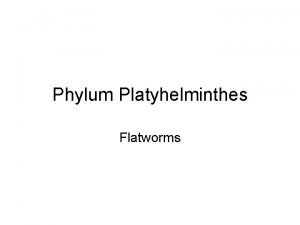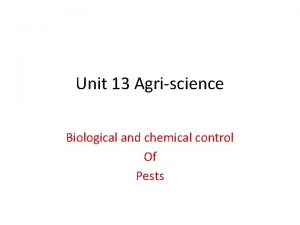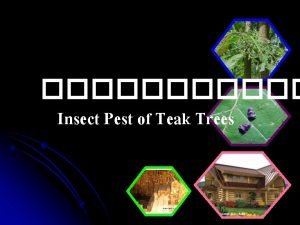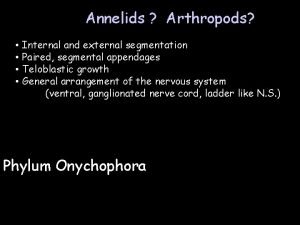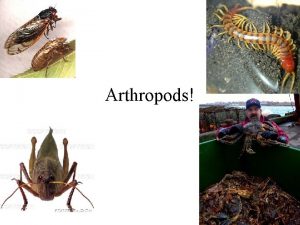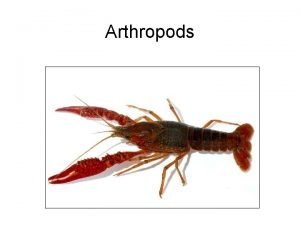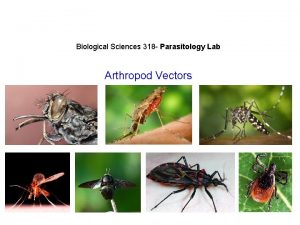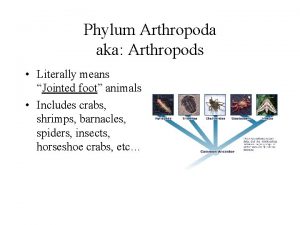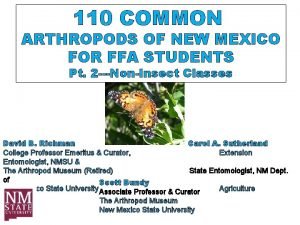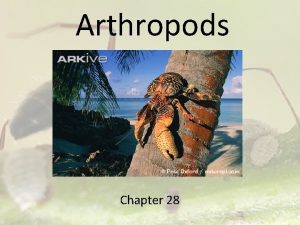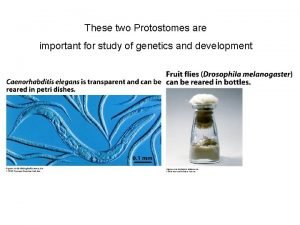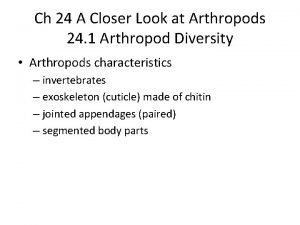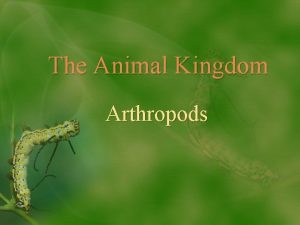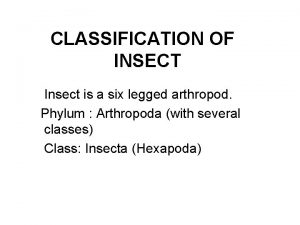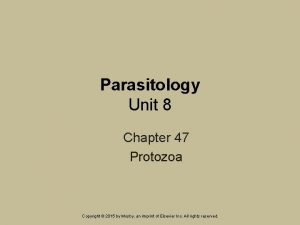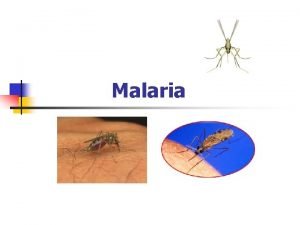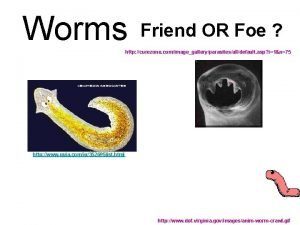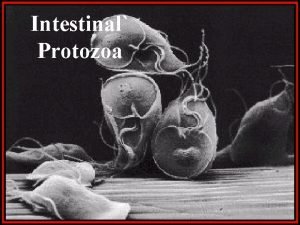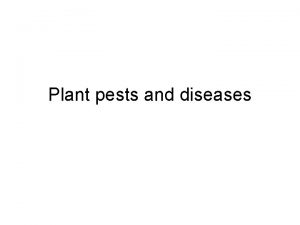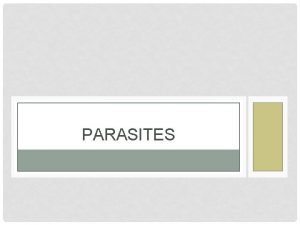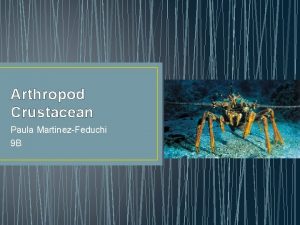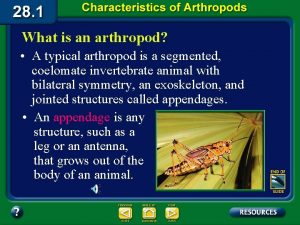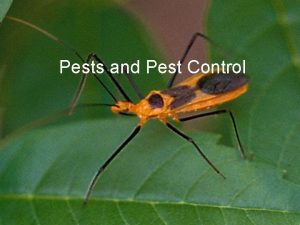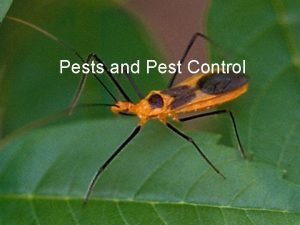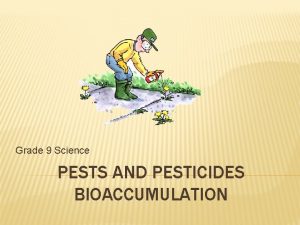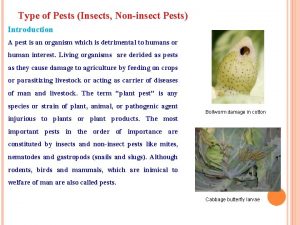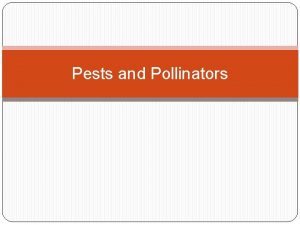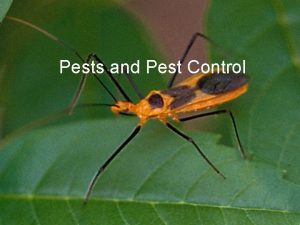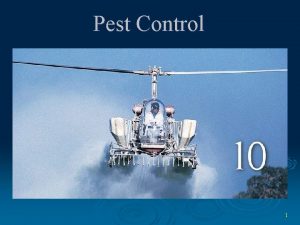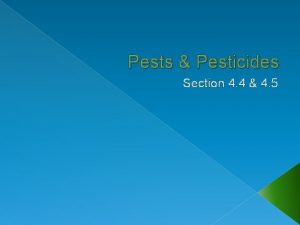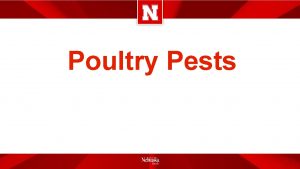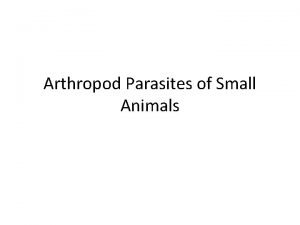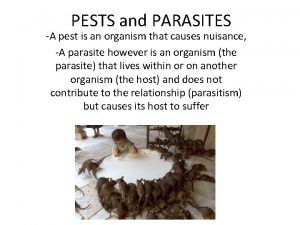External Parasites External Parasites l l Arthropod pests




































- Slides: 36

External Parasites

External Parasites l l Arthropod pests limit production in cattle industry by affecting animals in many ways. External parasites are the most serious threat since they feed on body tissues such as blood, skin and hair. The wounds and skin irritation produced by these parasites often result in discomfort and irritation for the animal. More significant, however, is that any bloodsucking arthropod may transmit diseases from infected animals to healthy ones.

External parasites such as lice, flies, ticks, cattle grubs and mites are a serious problem to livestock breeders. l These pests are most prevalent during spring and summer months; however, southeast Texas's warm climate permits many pests to live year-round. l

Flies l Flies are characterized by having one pair of wings. They have complete metamorphosis with egg, larva, pupa and adult stages in their life history. About 20 families of flies are of veterinary importance House Fly CREDITS: J. F. Butler, University of Florida

Horn Fly l l The horn fly is one of the most serious pests of cattle in Texas. It causes pain, annoyance and interference with feeding, resting and other normal activities. The fly pierces the skin to blood feed and is a persistent biter. With high summertime populations, they cause cattle to lose weight and lower milk production. Horn flies may cause open sores on the head and underline, which can predispose the animals to secondary infection. l Horn fly

Horn fly l l Eggs are laid exclusively in fresh (within 10 minutes of dropping) cattle manure. Larvae hatch in about 18 hours and feed on the dung, passing through 3 stages in 3 to 5 days. The pupal stage lasts 3 to 5 days, and the adults which emerge have a preoviposition period of 3 days. Mating takes place on the host, and females can lay about 200 eggs in their lifetime. The life cycle from egg to adult takes about 10 to 14 days

Horse and Deer Flies l l Horse flies and deer flies , also called Tabanids, are insects that are usually strong fliers. As with mosquitoes, only females bite. They are usually daytime feeders and are vicious biters. Because of their painful bites and frequent attacks, horse flies produce frenzied behavior in their hosts, sometimes causing them to run long distances in an effort to escape.

Tabanids l l l Tabanids introduce an anticoagulant into the wound when they bite that causes blood to ooze. These wounds are excellent sites for secondary invasion of other insects and diseases, and also cause more blood loss. Being intermittent feeders, they can be important mechanical transmitters of diseases such as anthrax, tularemia and anaplasmosis.

Stable Flies l l l Bite wounds also can serve as sites for secondary infection. These flies are easily interrupted in feeding and are mechanical transmitters of anthrax and anaplasmosis The stable fly, or dog fly, is similar to the house fly in size and color, but the bayonet-like mouthparts of the stable fly differentiate it from the house fly. Unlike the flies previously discussed, both sexes of the stable fly are vicious biters. Stable flies cause irritation and weakness in animals and account for much blood loss in severe cases.

Non-Blood Sucking Flies Cattle Grubs l l Two species of cattle grubs are found in the United States, the common cattle grub and the northern cattle grub. The common cattle grub lays its eggs chiefly on the hair of cattle, attaching 5 to 15 eggs to a single hair Eggs hatch within about 4 days, and the maggots burrow through the skin. Migration of the first stage larvae of the common cattle grub is through connective tissue, assisted by enzyme secretion.

Cattle Grubs The larvae produce two types of injury. --First there is irritation caused by larval migrations in the body of the host and later by emergence from beneath the skin. --Second, the escape of the larva from the warble leaves an open, running wound that is persistent and subject to secondary infection The grubs must be killed before they reach the gullet or spinal cord, because killing grubs in these areas can cause swelling, and paralysis or death l

Infestations of Fly Maggots (Myiasis) l l Myiasis is the presence of fly larvae in the living tissue of the host. Several kinds of maggots infest the wounds of warm-blooded animals; however, the only one that feeds exclusively on live flesh is the primary screwworm

Lice l l Most lice are permanent ectoparasites, spending their entire lives on the host. Both immature and adult stages are parasitic; therefore, they must remain on their hosts to survive. Sucking lice are found on the head, neck and brisket during winter to early spring Lice are generally transmitted from one animal to another by contact. Transmission from herd to herd is usually accomplished by introduction of carrier animals

Mites l l l Mange mites (Psoroptes, Sarcopte, and Chorioptes) feed on the surface or burrow just beneath the skin, making very slender, winding tunnels The fluid discharged at the tunnel openings dries to form nodules. A toxin is also secreted which causes intense irritation and itching The infection may spread over the entire body, forming large, cracked scabs on the thickened skin

Mange lesions

Mosquitoes l l l Mosquitoes are small insects with piercing-sucking mouthparts, and scales on their wings. Female mosquitoes suck blood but do not always need blood to lay the first batch of eggs. Several species of mosquitoes attack livestock causing painful bites, unthriftiness, and occasionally death by suffocation or heavy blood loss

Ticks l l l Ticks are easily distinguished from insects, since the body is not definitely divided and the strong fusion of the thorax and abdomen produces a sac-like, leathery appearance. They belong to the class Arachnida A distinct head is lacking, but there is a head-like structure which bears recurved teeth that are inserted into the wound, allowing the tick to hold on strongly. Females can be greatly distended and are bean-like in form when fully engorged. Ticks have 4 developmental stages: egg, 6 -legged seed or larval stage, 8 -legged nymphal stage and 8 -legged adult.

Ticks l l The effects of ticks upon the host include inflammation, itching and swelling at the bite site, blood loss, production of wounds that may serve as sites for secondary invasion, obstruction of body openings and paralysis from the injection of toxic fluids. They also transmit many diseases, including anaplasmosis, bovine piroplasmosis and tularemia.

l l The cattle tick, Boophilus microplus, is a significant ectoparasite of cattle and a vector for important diseases such as babesiosis and anaplasmosis. B. microplus requires high humidity and ambient temperatures of at least 15 -20 o C for egg laying and hatching. Differentiate from l Haemophysalis spp l Ixodes holocyclus

Keys To Pesticide Safety l l l Before using any pesticide, stop and read the precautions. Read the label on each pesticide container before each use. heed all warnings and precautions. Store all pesticides in their original containers away from food or feed. Keep pesticides out of the reach of children, pets and livestock. Apply pesticides only as directed. Dispose of empty containers promptly and safely.

Hemolytic System Diseases

Babesiosis (Redwater fever) This parasitic disease is usually first reported in May/June when its tick host first becomes active.

What is Babesiosis? l l l Babesiosis is an infection of the red blood cells by a single cell parasite of the genus Babesia Two important species in cattle— B bigemina and B bovis The disease is spread between cattle by ticks The babesia is injected into the bloodstream by the tick and then invades the red blood cells and begins dividing, eventually rupturing the cell. Clinical signs begin around 2 weeks after infection.

Boophilus annulatus: Vector for Babesia bigemina

Boophillus microplus: Vector for Babesia bovis

Clinical Signs Increased temperature l Diarrhea which ceases after around 36 hours and then becomes constipation l Red urine (due to haemoglobin produced by the rupture of the red blood cells) which becomes darker with time l Increased pulse rate l Abortion of pregnant cows l Death. l

Diagnosis On the clinical signs described above l Recent movement to pastures known to harbour ticks l Blood smears can show up the parasite l Babesia in blood smear

Treatment l l Tetracyclines are the drug of choice for treating Cattle dip for Babesia control

Prevention l Identification of risk areas Prophylactic treatment of cattle about to be moved to a risk area Tick control Vaccine not yet available

Anaplasmosis Anaplasma marginale Anaplasmosis is a vector-borne infectious, hemolytic, rickettsial disease of cattle, sheep, goats, and other wild ruminants.

l l l Young calves seem to have an innate resistance to the disease while the acute form generally occurs in cattle from 1 to 3 years. In cattle over 3 years, the peracute or most severe form, with rapid onset and death, predominates. Animals that survive anaplasmosis can become carriers for life and act as a reservoir of infection for susceptible animals.

-The disease commonly occurs during the warm months when arthropod vectors, both biological and mechanical are abundant. -Ticks are the most important biological vector

Biological transmission can occur with other vectors such as blood sucking flies (horse and stable flies) and mosquitoes. Accordingly, humans can be a mechanical vector by using anaplasma-contaminated equipment such as scalpels, needles, and tatoo equipment on susceptible animals

Symptoms l l Anaplasmosis is characterized by progressive anemia due to extravascular destruction of infected and uninfected erythrocytes Animals with peracute infections succumb within a few hours of the onset of clinical signs. Acutely infected animals lose condition rapidly The urine may be brown but, in contrast to babesiosis, hemoglobinuria does not occur Bos indicus breeds of cattle appear to possess a greater resistance to A marginale infection than B taurus breeds

Diagnosis l Anaplasma marginale infection in bovine blood, Wright. Giemsa, 100 X oil immersion. Intracellular organisms appear as basophilic, spherical inclusions that are generally located near the margin of erythrocytes. Frequent echinocytes are present. The hemat Courtesy of Dr. John W. Harvey

Treatment: Tetracycline antibiotics and imidocarb are currently used for treatment. l Prompt administration of tetracycline drugs (tetracycline, chlortetracycline, oxytetracycline, rolitetracycline, doxycycline, minocycline) in the early stages of acute disease (eg, PCV >15%) usually ensures survival l
 Flatworms acoelomates
Flatworms acoelomates Cupboard bugs
Cupboard bugs Journey 2050 student handout 4 matching activity
Journey 2050 student handout 4 matching activity Unit 13 biological cultural and chemical control of pests
Unit 13 biological cultural and chemical control of pests Teak insect
Teak insect Cvs poinsettia
Cvs poinsettia Pests can cause which two types of contamination?
Pests can cause which two types of contamination? Journey 2050 student handout 2 word search
Journey 2050 student handout 2 word search Arthropod
Arthropod Annelids vs arthropods
Annelids vs arthropods Arthropod groups
Arthropod groups Three things in common
Three things in common Appendage meaning
Appendage meaning Arthropod subkingdom
Arthropod subkingdom Arthropoda
Arthropoda External skeleton animals
External skeleton animals Arthropod
Arthropod Arthropods characteristics
Arthropods characteristics Are crustaceans protostomes
Are crustaceans protostomes Arthropod
Arthropod Chapter 26 section 1 arthropod characteristics
Chapter 26 section 1 arthropod characteristics Arthropod
Arthropod Chapter 26 section 1 arthropod characteristics
Chapter 26 section 1 arthropod characteristics Hydras
Hydras Arthropod
Arthropod Chapter 26 section 2 arthropod diversity
Chapter 26 section 2 arthropod diversity Six legged arthropod
Six legged arthropod Sarcomastigophora are unicellular immotile parasites
Sarcomastigophora are unicellular immotile parasites Epidemiology of malaria
Epidemiology of malaria What do parasites eat
What do parasites eat Bankers are parasites
Bankers are parasites Trichinella
Trichinella Parasites alimentaires
Parasites alimentaires Parasites of livestock vocabulary
Parasites of livestock vocabulary Infective stage
Infective stage Parasite consumer
Parasite consumer 2 example of parasitism
2 example of parasitism
